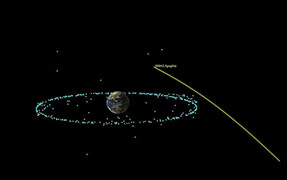Improving CCD radiation tolerance
CCDs are used for direct digital imaging and spectroscopy across a broad range of the electromagnetic spectrum, from the near-IR through the visible and UV to soft and medium x-ray wavelengths. At e2v, we provide imaging solutions for applications requiring high reliability and high performance, often in challenging environmental conditions. One such example is space imaging, where devices must survive satellite launch, temperature extremes, exposure to radiation, and a mission lifetime of up to 20 years.
CCD sensors are susceptible to radiation damage, leading to degraded performance. The devices can sometimes be shielded, but particularly for space missions the costs per kilogram can be prohibitive. The consequences are that tradeoffs have to be made between launch cost and sensor performance. Radiation can affect CCDs in four main ways, either causing an increase in the background dark signal, introducing localized random-telegraph signals (RTSs), changes in the threshold voltage, and/or reducing the charge-transfer efficiency (CTE). These effects result in lower dynamic range, additional noise in low-signal images, a change in operating conditions, and image smearing.
In general, ionizing radiation (such as x- and gamma rays) causes an increase in dark signal and threshold shift, while high-energy particles (such as protons and neutrons) cause lattice-displacement damage. This produces trapping centers, leading to CTE degradation and RTS effects. Ionizing radiation generates electron-hole pairs in the device's dielectric layer, which can be separated if a potential is applied. Holes becomes trapped at interfaces in the gate dielectric layer, causing a threshold-voltage shift. The threshold shift associated with e2v's standard process is typically 100–200mV per kRad (for silicon, Si) and results in a maximum radiation tolerance before significant device degradation of 7–10kRad (Si).
Over the last 10 years, we have carried out various experiments to determine the best approach for producing devices that are less susceptible to ionizing radiation. We have incorporated a number of design features in our devices, but our principal approach is to reduce the gate-dielectric thickness. We recently fabricated CCD47-20 devices (scientific frame-transfer arrays containing 1000×100013μm2 pixels) with a slightly thinner dielectric, to avoid tunneling into the silicon. We radiated the devices with 500kRad (Si) of gamma radiation, and the threshold shift was only 6mV/kRad (Si). The increase in dark signal was also significantly reduced, which means that—for many space missions—the impact of threshold shift and dark-signal increase can be ignored.
One reason that CCD manufacturers have been averse to reducing the dielectric-layer thickness (although the mainstream semiconductor technology has seen ever-decreasing oxide films) is that the thicker dielectric layer has a very high yield. This facilitates fabrication of very-large-area devices, such as e2v's CCD230-84 with 36cm2 of active area (see Figure 1). Process improvements now allow use of thinner gates, and we are currently making a 13cm2 device with the new rad-hard process that is available as a standard option.
One of the main trap species generated by lattice displacement arises from the implanted atoms used to create the CCD channel for charge transfer. In a standard CCD, the channel implant is phosphorous in p-type silicon (dominated by holes). We have experimented with boron implants in n-type silicon (dominated by free electrons) to avoid the formation of phosphorous-centered traps. The results of our initial studies have shown superior performance post proton irradiation by factors of about five serial (1MHz) and two parallel (1ms line time). Another approach used to improve radiation tolerance to displacement damage is to reduce the volume of silicon that the photogenerated charge interacts with through channel shaping. This improves the CTE for weak signals and has been implemented in the CCD43 employed in the Wide Field Camera 3 aboard the Hubble Space Telescope.
We are at the forefront of space and scientific imaging and have developed processes to achieve improved radiation tolerance. Further development of p-channel devices and channel shaping are under way, and testing to even higher ionizing radiation doses of the rad-hard sensors is planned.1




